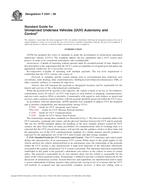Potřebujeme váš souhlas k využití jednotlivých dat, aby se vám mimo jiné mohly ukazovat informace týkající se vašich zájmů. Souhlas udělíte kliknutím na tlačítko „OK“.
ASTM F2541-06
Standard Guide for Unmanned Undersea Vehicles (UUV) Autonomy and Control (Withdrawn 2015)
Automaticky přeložený název:
Standardní Příručka pro bezpilotní podvodní vozidla ( UUV ) Autonomie a Control (Withdrawn 2015 )
NORMA vydána dne 15.8.2006
Informace o normě:
Označení normy: ASTM F2541-06
Poznámka: NEPLATNÁ
Datum vydání normy: 15.8.2006
Kód zboží: NS-54095
Počet stran: 24
Přibližná hmotnost: 72 g (0.16 liber)
Země: Americká technická norma
Kategorie: Technické normy ASTM
Anotace textu normy ASTM F2541-06 :
Keywords:
autonomous vehicle, autonomy, control architecture, unmanned undersea vehicle, ICS Number Code 47.080 (Small craft)
Doplňující informace
| 1. Scope | ||||||||||||
|
1.1 This guide covers the need for UUVs to operate autonomously, without constant human intervention, and with flexibility based on their payloads and missions places unique requirements on UUV developers. Because the UUV community is expected to expand both its developer base and its user base in the next several years, it recognizes that success relies upon a well-written standard. The standard must encourage compatibility and reconfigurability, provide a common language to describe functional capabilities, and enable meaningful quantitative performance evaluation. 1.2 The scope of this guide includes those characteristics in a UUV system which, when implemented in a detailed design, result in a UUV that is capable of operating for extended periods of time without external intervention. Implicit in this statement is the requirement that the UUV execute its designated sortie plan. Non-expendable UUVs must also return to a rendezvous point for recovery. The top level concept of such an autonomous system is presented in Fig 3. The functional relationships identified in this block diagram will be discussed further in Section 4. 1.3 This guide contains a table of terminology so that autonomy and control can be described within the context of a common language, where all terms have consistent and clearly defined meaning. As introduced in Fig 3, this guide defines high level functional capabilities of the autonomy controller, the vehicle controller, and the payload controller. Correspondingly high level interfaces are also defined. 1.4 Section presents the capabilities that an autonomous system is required to have. The table in this section concentrates on the functional capabilities of the total system, as opposed to the capabilities of the component controllers. A method for verification of the capability is also presented. 1.5 Section presents a set of tables that index the system autonomy capabilities according to three criteria: Situational Awareness, Decision-making, Planning, and Control, and External Interactions. Such a set of qualifiers determines a Level of Autonomy (LOA) measurement for each of the three criteria. No attempt is made to combine these disparate measures into a single index. 1.6 The following are outside the scope of this guide and no part of this guide should be construed to prescribe requirements associated with these areas. Payloads-outside of the generic functions of the Payload controller and the top level interfaces, the design and implementation of payload subsystems are not addressed in this guide. Vehicles-outside of the generic function of the Vehicle controller and the top level interfaces, the design and implementation of the vehicle subsystems are not addressed in this guide. Safety-this guide does not address safety concerns, if any, associated with the use of the UUV system. It is the responsibility of the system designer to establish appropriate safety and health practices and determine the applicability of the regulatory limitations prior to use. Security-this guide does not address security concerns. It is the responsibility of the program referencing this guide to establish security mechanisms that are appropriate for the intended use of the UUV system and the requirements of the end-user of the system data.1.7 These standards are intended to support the decision process for the acquisition and development of non-specific UUV systems. To the extent that UUV systems are specified, procured, and developed under a modular open system design approach, the autonomy standards presented herein will foster interoperability and reusability within the UUV community. This standard does not purport to address all of the safety concerns, if any, associated with its use. It is the responsibility of the user of this standard to establish appropriate safety and health practices and determine the applicability of regulatory limitations prior to use. |
||||||||||||
| 2. Referenced Documents | ||||||||||||
|
Odebírejte informace o nově vydaných normách ZDARMA:
Chcete pravidelně odebírat informace o nově vycházejících normách z celého světa a to zcela zdarma?
Přihlašte se k odběru. Vše je velice jednoduché a absolutně ZDARMA.
Na výběr máte vydavatele z celého světa.




 Cookies
Cookies
